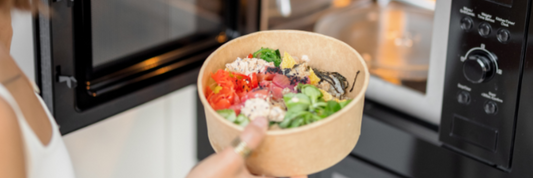Glass jars, with their timeless appeal and versatility, have become a staple in kitchens around the world. But what about their lids? Can glass jar lids be recyclable? In this article, we'll delve into the world of glass jar lids, exploring their composition, recyclability, and the environmental impact of their disposal.
- Top 10 Creative Canning Jars Uses You Should Know
- What to Do with Old Candle Jars: 10 Easy and Creative Ideas
- Plastic Bottle Garden Ideas: Top 5 Easy and Fun Ideas for Restaurant
What Are Glass Jar Lids Made Of?
To answer the question: “Are glass jar lids recyclable?”, in the first section, we'll explore the materials commonly used to make glass jar lids. This will lay the groundwork for understanding their recyclability, which we'll delve into in the following section.
Glass jar lids are typically crafted from a combination of materials, primarily metal and plastic.
- Metal Lids: These are often made of aluminum or tin-plated steel. Aluminum lids are lightweight and durable, making them a popular choice for many food and beverage products. Tin-plated steel lids provide a protective barrier against corrosion and oxidation, ensuring the quality of the product inside.
- Plastic Lids: Plastic lids are commonly made from polypropylene or polyethylene. These plastics are lightweight, flexible, and resistant to heat and moisture. They are often used for products that require a tight seal, such as jams, jellies, and sauces.
Now that we have a solid understanding of the materials used to make glass jar lids, we can delve into the crucial question: Are these lids recyclable? Let's explore their recyclability in the next section.
The Recyclability of Metal Lids
Metal lids, primarily composed of aluminum or tin-plated steel, offer a promising avenue for recycling. Let's delve into the process and challenges associated with their recycling.
The Recycling Process of Metal Lids
The journey of metal lids from our homes to new products involves several stages:
- Collection: Metal lids are gathered from various sources, including households, businesses, and recycling centers.
- Sorting: The collected lids are meticulously sorted to separate them from other materials and identify their specific metal type.
- Cleaning: The lids undergo a thorough cleaning process to remove any residual food or debris.
- Shredding: The cleaned lids are shredded into smaller pieces.
- Melting: The shredded metal is melted down to create molten metal.
- Molding: The molten metal is poured into molds to create new metal products, such as beverage cans or automotive parts.

Challenges and Limitations When Recycling Metal Glass Jar Lids
While metal lids are recyclable, several factors can hinder the recycling process:
- Contamination: If metal lids are not cleaned properly, food residue can contaminate the recycling process, reducing the quality of the recycled metal.
- Sorting: Smaller metal lids, such as those from spice jars, can be difficult to sort and may be missed by recycling facilities.
- Market Demand: The demand for recycled metal can fluctuate, affecting the economic viability of recycling programs.
Proper Disposal and Separation:
To maximize the recyclability of metal lids, it's essential to dispose of them correctly:
- Clean the lids: Remove any food residue or labels.
- Separate the lids: Keep metal lids separate from other recyclables, such as paper and plastic.
- Check local guidelines: Consult your local recycling program for specific instructions on how to recycle metal lids in your area.
The Recyclability of Plastic Lids
Plastic lids, often made from polypropylene or polyethylene, present a more complex scenario when it comes to recycling. While some types of plastic are recyclable, the specific type of plastic used for the lid, along with local recycling infrastructure, can significantly impact its recyclability.
The Recycling Process of Plastic Glass Jar Lids
The recycling process for plastic lids is similar to that of other plastic items:
- Collection: Plastic lids are collected from various sources, including households and businesses.
- Sorting: The collected lids are sorted based on their plastic type, typically using a combination of manual and automated sorting techniques.
- Cleaning: The lids are cleaned to remove any food residue or debris.
- Shredding: The cleaned lids are shredded into smaller pieces.
- Melting: The shredded plastic is melted down to create molten plastic.
- Molding: The molten plastic is poured into molds to create new plastic products.

Challenges and Limitations When Recycling Glass Jars Lids Made by Plastic
Several factors can hinder the recycling of plastic lids:
- Plastic Type: Not all types of plastic are widely recyclable. Polypropylene and polyethylene, commonly used for plastic lids, may or may not be accepted by local recycling programs.
- Contamination: Food residue or other contaminants can degrade the quality of the recycled plastic, making it less valuable.
- Recycling Infrastructure: The availability of recycling facilities and the capacity to process plastic lids can vary significantly from region to region.
Local Recycling Guidelines and Specialized Programs
To determine the recyclability of plastic lids in your specific area, it's essential to check with your local recycling program. Some regions have specialized programs that accept plastic lids, while others may not.
In addition to local recycling programs, some companies and organizations offer specialized recycling programs for plastic lids. These programs often collect and recycle plastic lids that are not accepted by traditional recycling programs.
Conclusion
The recyclability of glass jar lids depends largely on the material they are made from. Metal lids, primarily aluminum and tin-plated steel, are generally recyclable, but their successful recycling hinges on proper cleaning, sorting, and adequate market demand. Plastic lids, often made from polypropylene or polyethylene, pose a greater challenge due to the variability in plastic types and the limitations of recycling infrastructure.









